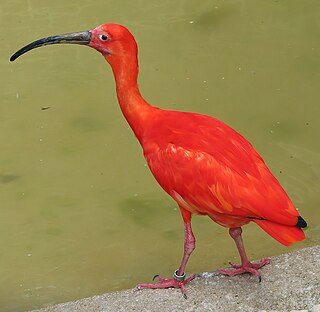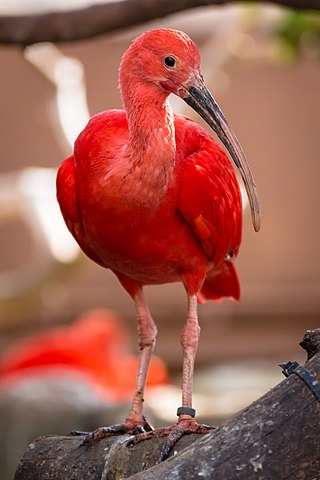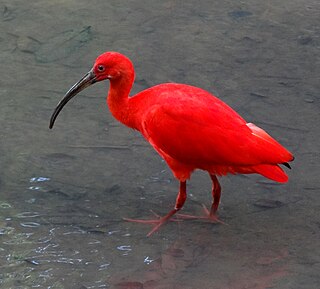
The ibis are a group of long-legged wading birds in the family Threskiornithidae that inhabit wetlands, forests and plains. "Ibis" derives from the Latin and Ancient Greek word for this group of birds. It also occurs in the scientific name of the western cattle egret mistakenly identified in 1757 as being the sacred ibis.

The family Threskiornithidae includes 36 species of large wading birds. The family has been traditionally classified into two subfamilies, the ibises and the spoonbills; however recent genetic studies have cast doubt on this arrangement, and have found the spoonbills to be nested within the Old World ibises, and the New World ibises as an early offshoot.

The American white ibis is a species of bird in the ibis family, Threskiornithidae. It is found from Virginia via the Gulf Coast of the United States south through most of the coastal New World tropics. This particular ibis is a medium-sized bird with an overall white plumage, bright red-orange down-curved bill and long legs, and black wing tips that are usually only visible in flight. Males are larger and have longer bills than females. The breeding range runs along the Gulf and Atlantic Coast, and the coasts of Mexico and Central America. Outside the breeding period, the range extends further inland in North America and also includes the Caribbean. It is also found along the northwestern South American coastline in Colombia and Venezuela. Populations in central Venezuela overlap and interbreed with the scarlet ibis. The two have been classified by some authorities as a single species.

The scarlet ibis, sometimes called red ibis, is a species of ibis in the bird family Threskiornithidae. It inhabits tropical South America and part of the Caribbean. In form, it resembles most of the other twenty-seven extant species of ibis, but its remarkably brilliant scarlet coloration makes it unmistakable. It is one of the two national birds of Trinidad and Tobago, and its Tupi–Guarani name, guará, is part of the name of several municipalities along the coast of Brazil.

The white-faced ibis is a wading bird in the ibis family, Threskiornithidae.

The Australian white ibis is a wading bird of the ibis family, Threskiornithidae. It is widespread across much of Australia. It has a predominantly white plumage with a bare, black head, long downcurved bill, and black legs. While it is closely related to the African sacred ibis, the Australian white ibis is a native Australian bird. Contrary to urban myth, it is not a feral species introduced to Australia by people, and it does not come from Egypt.

The cattle egret (Bubulcus) is a cosmopolitan genus of heron found in the tropics, subtropics, and warm-temperate zones. According to the IOC bird list, it contains two species, the western cattle egret and the eastern cattle egret, although some authorities regard them as a single species. Despite the similarities in plumage to the egrets of the genus Egretta, it is more closely related to the herons of Ardea. Originally native to parts of Asia, Africa, and Europe, it has undergone a rapid expansion in its distribution and successfully colonised much of the rest of the world in the last century.

The Réunion ibis or Réunion sacred ibis is an extinct species of ibis that was endemic to the volcanic island of Réunion in the Indian Ocean. The first subfossil remains were found in 1974, and the ibis was first scientifically described in 1987. Its closest relatives are the Malagasy sacred ibis, the African sacred ibis, and the straw-necked ibis. Travellers' accounts from the 17th and 18th centuries described a white bird on Réunion that flew with difficulty and preferred solitude, which was subsequently referred to as the "Réunion solitaire".

The little blue heron is a small heron of the genus Egretta. It is a small, darkly colored heron with a two-toned bill. Juveniles are entirely white, bearing resemblance to the snowy egret. During the breeding season, adults develop different coloration on the head, legs, and feet.

The white-shouldered ibis is a large species of bird in the family Threskiornithidae. It is native to small regions of Southeast Asia, and is considered to be one of the most threatened bird species on this part of the continent.

The African sacred ibis is a species of ibis, a wading bird of the family Threskiornithidae. It is native to much of Africa, as well as small parts of Iraq, Iran and Kuwait. It is especially known for its role in Ancient Egyptian religion, where it was linked to the god Thoth. The species is currently extirpated from Egypt.

Highlands Hammock State Park is a 9,000-acre (3,640 ha) park 4 miles (6 km) west of Sebring in Highlands County, Florida, off U.S. 27. The park opened in 1931, four years before the Florida state park system was created. It was listed on the National Register of Historic Places in 2018.

Ibis is a French brand of economy hotels owned by Accor. Created in 1974, Ibis became Accor's economy megabrand in 2011 with the rebranding of Ibis Styles and Ibis Budget from All Seasons and Etap Hôtel respectively. As of December 2019, there were 1,218 hotels under the Ibis brand, with 159,180 rooms in total across 70 countries.

Collier–Seminole State Park is a Florida State Park located on US 41, 17 miles (27 km) south of Naples, Florida. The park is the home of a National Historic Mechanical Engineering Landmark, the Bay City Walking Dredge used to build the Tamiami Trail through the Everglades. The park includes of 6,430 acres (26 km2) of mangrove swamp, cypress swamps, salt marshes, mangrove river estuaries, and pine flatwoods. Among the wildlife of the park are American alligators, raccoons, ospreys, and American white ibis. brown pelicans, wood storks, bald eagles, red-cockaded woodpeckers, American crocodiles, Florida black bears and Big Cypress fox squirrels also inhabit the park.

Eudocimus is a genus of ibises, wading birds of the family Threskiornithidae. They occur in the warmer parts of the New World with representatives from the southern United States south through Central America, the West Indies, and South America.

Faver-Dykes State Park is a Florida State Park located 15 miles south of St. Augustine, near the intersection of I-95 and US 1, and bordering Pellicer Creek, a designated state canoe trail. Activities include fishing, picnicking, boating, canoeing, camping and wildlife viewing.

Tomoka State Park is an 2,000-acre (8.1 km2) Florida State Park located along the Tomoka River, three miles (5 km) north of Ormond Beach on North Beach Street.

Sebastian the Ibis is the mascot for the Miami Hurricanes of University of Miami. He is an anthropomorphic white ibis with a Miami Hurricanes football jersey, number 0.

Green Cay Wetlands is a nature preserve located in Boynton Beach, Florida. The 100-acre (0.40 km2) property was purchased in 1999 from Ted and Trudy Winsberg, who used the property for farming. The Winsbergs sold the property for 1/3 of its appraised value with the condition that it would be made into a wetland. Construction began in July 2003. It was created jointly by the Palm Beach County Utilities Department and the Palm Beach County Parks and Recreation Department in 2004. This park includes 1.5 miles (2.4 km) of an elevated wooden boardwalk, which takes visitors through various habitats, including cabbage palm hammock, cypress swamp, wetland hammock, and tropical hardwood hammock. The boardwalk also features a Seminole chickee hut as well as several gazebos, which have descriptive signs offering information on the wildlife and plant life.
Lake Harney, named for General William S. Harney, is a lake that straddles the county line between Volusia County and Seminole County, Florida, at the coordinates latitude 28°45’21.404", longitude 81° 03’36.019". It is fed by the Saint Johns River which flows through central Florida and feeds many of the nearby lakes such as Lake Monroe.


















